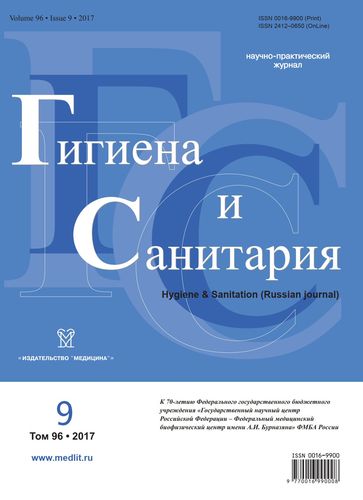Practical approbation of the developed measures on ecological-hygienic and toxicological estimation of the environment in the district of the former objects of the Ministry of Defense
- Authors: Chistyakov S.V.1, Alekhnovich A.V.2, Tarabara A.V.3
-
Affiliations:
- A.I. Burnazyan Federal Medical Biophysical Centre
- Russian Medical Academy of Continuing Vocational Education
- Limited Liability Company «EcoRK»
- Issue: Vol 96, No 9 (2017)
- Pages: 833-839
- Section: ENVIRONMENTAL HYGIENE
- Published: 21.10.2020
- URL: https://rjraap.com/0016-9900/article/view/640733
- DOI: https://doi.org/10.47470/0016-9900-2017-96-9-833-839
- ID: 640733
Cite item
Full Text
Abstract
The evaluation of the sanitary-hygienic and ecological state of the environment on the territory of the location of the former silo launchers of intercontinental ballistic missiles after their partial elimination, as practical testing of the main provisions of the developed draft methodological manual on ensuring of environmental and hygienic safety of the sites for placing silo launchers after their decommissioning and Land reclamation. A comprehensive observation of the combat launch positions of liquid intercontinental ballistic silo based missiles after their decommissioning and partial liquidation was carried out. In accredited testing laboratories in soil, water, building structures, there were carried out.studies of the qualitative and quantitative content of unsymmetrical dimethylhydrazine (UDMH) and its degradation products, heavy metals, radionuclides. In studied soil samples unsymmetrical dimethylhydrazine was found to be in the soil in 69.4.7% of cases, and in 40.8% of cases in the studied samples, the excess of the MPC content of UDMH was recorded by 1.2 - 32 times. The study of soil on the degradation products of UDMG revealed their presence in some substances in most of studied samples, but their values did not exceed the MPC. The content of a number of heavy metals, both anthropogenic (zinc, lead, nickel) and natural (cobalt, chromium) nature was noted to exceed the maximum permissible and approximately permissible concentrations. It has been established that if the incomplete disposal of the former chemically hazardous facilities of the Ministry of Defense and land reclamation is concerned, the environment may contain toxic and highly toxic substances in concentrations exceeding the established standards. This circumstance determines the potential danger of decommissioned, but not properly disposed former military facilities for the environment, as well as for the local population. The experience gained during the practical activities made it possible to make the necessary additions and changes to the final version of the draft document on ensuring environmental and hygienic safety of the areas where the silo launchers were placed after their decommissioning and land reclamation.
About the authors
Sergey V. Chistyakov
A.I. Burnazyan Federal Medical Biophysical Centre
Author for correspondence.
Email: serga.1964@yandex.ru
MD, researcher of the Laboratory of environmental hygiene of the A.I. Burnazyan Federal Medical Biophysical Centre, Moscow, 123182, Russian Federation.
e-mail: serga.1964@yandex.ru
Russian FederationA. V. Alekhnovich
Russian Medical Academy of Continuing Vocational Education
Email: noemail@neicon.ru
Russian Federation
A. V. Tarabara
Limited Liability Company «EcoRK»
Email: noemail@neicon.ru
Russian Federation
References
- GOST 12.1.007–76. Occupational safety standards system. Harmful substances. Classification and general safety requirements (with Changes No. 1 and No. 2). Moscow; 1976. (in Russian)
- The results of environmental and hygienic control in the territory of site No. 11 of the former facility 750 and proposals for amending the draft Guide with the application of sampling and analysis protocols: the final report. Moscow: EkoRK; 2014. (in Russian)
- The results of environmental and hygienic control at the site of site No. 23 of the former facility 750 and proposals for amending the draft Guide with the application of sampling and analysis protocols: the final report. Moscow: EkoRK; 2015. (in Russian)
- Practical approbation of methodological approaches, laid down in the draft of the Manual «Ensuring environmental and hygienic safety of the territories for placing mine launchers after their decommissioning and land reclamation» (cipher: «Site»): Progress report on PMGM (final). Moscow; 2015. (in Russian)
- Federal Target Program «National System of Chemical and Biological Safety of the Russian Federation (2009–2014)». Moscow; 2008. (in Russian)
- Filatov B.N., Britanov N.G., Varenik V.I. Liquidation or Re-profiling of Chemically Hazardous Objects. Ecological and Hygienic Problems and their Solution [Likvidatsiya ili pereprofilirovanie khimicheski opasnykh ob»ektov. Ekologo-gigienicheskie problemy i ikh reshenie]. Volgograd; 2015. (in Russian)
- Methodological manual on the organization and order of sampling of industrial and environmental facilities for the analysis of components of rocket fuels and products of its destruction. Moscow; 2014. (in Russian)
- Uyba V.V., Kotenko K.V., Kushnevoy V.S. Harmful Chemicals in the Rocket and Space Industry: A Handbook [Vrednye khimicheskie veshchestva v raketno-kosmicheskoy otrasli: Spravochnik]. Moscow; 2011. (in Russian)
- Gorshkova R.B., ed. Collection of Guidelines for the Determination of 1,1-Dimethylhydrazine and its Degradation Products in Industrial, Environmental and Biomedical Facilities [Sbornik metodicheskikh ukazaniy po opredeleniyu 1,1-dimetilgidrazina i produktov ego destruktsii v ob»ektakh proizvodstvennoy, okruzhayushchey sredy i biosredakh]. Moscow; 2011. (in Russian)
- GN 2.1.7.2735–10. The maximum permissible concentration (MPC) of 1,1-dimethylhydrazine (heptyl) in the soil. Moscow; 2010. (in Russian)
- SanPiN 2.1.7.1287–03. Sanitary and epidemiological requirements to the quality of soil and soils. Moscow; 2003. (in Russian)
- Okolelova A.A., Zheltobryukhov V.F. Petroleum Products in Soils and Methods for their Analysis [Nefteprodukty v pochvakh i metody ikh analiza]. Volgograd; 2013. (in Russian)
- SP 2.6.1.2523–09. Norms of radiation safety (NRB-99/2009). Moscow; 2009. (in Russian)
- Merkusheva M.G., Ubugunov L.L., Garmaev S.R. Biological Circulation of Macro- and Microelements in the Floodplain Cenoses of Transbaikalia [Biologicheskiy krugovorot makro- i mikroelementov v poymennykh tsenozakh Zabaykal'ya]. Ulan-Ude; 2003. (in Russian)
- Makeev O.V. Microelements in the Soils of Siberia and the Far East [Mikroelementy v pochvakh Sibiri i Dal'nego Vostoka]. Moscow: Nauka; 1973. (in Russian)
- GN 2.1.5.1315–03. The maximum permissible concentrations (MPC) of chemicals in water in water bodies of domestic and drinking and cultural and domestic water use. Moscow; 2003. (in Russian)
- GN 2.1.5.2280–07. The maximum permissible concentrations (MPC) of chemicals in water in water bodies of domestic and drinking and cultural and domestic water use. Additions and changes No. 1 to GN 2.1.5.1315–03. Moscow; 2003. (in Russian)
Supplementary files









